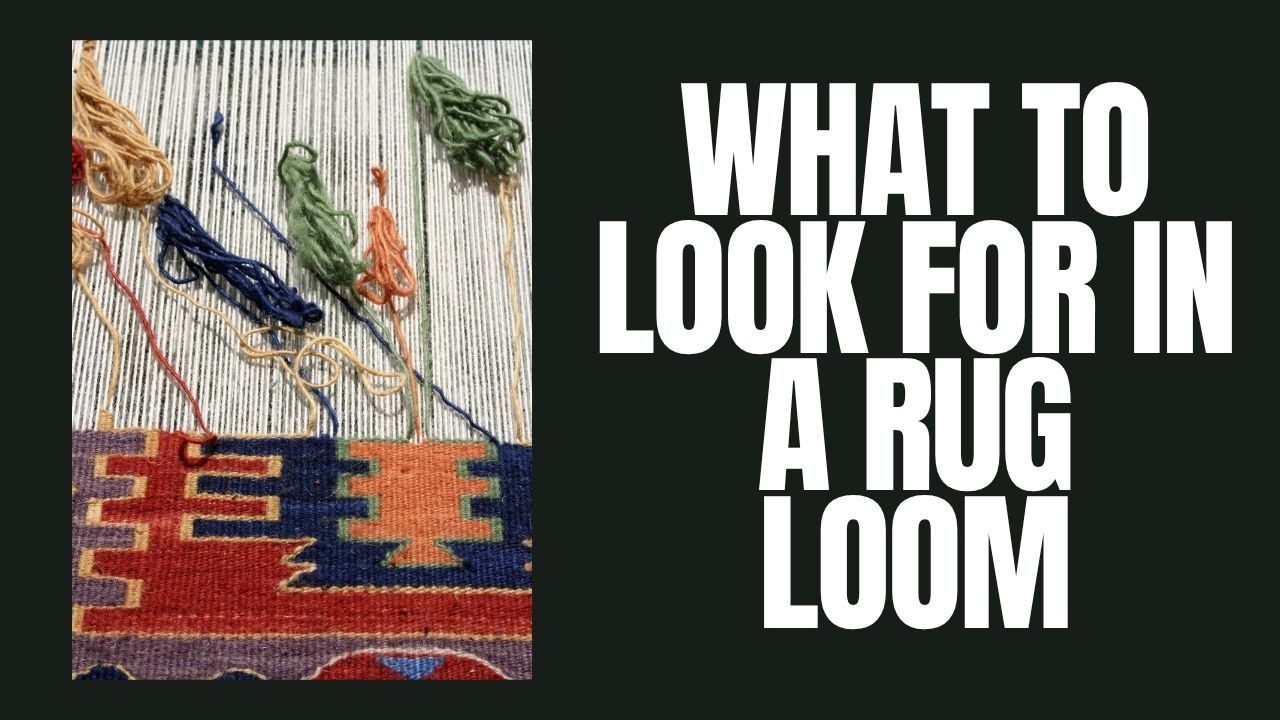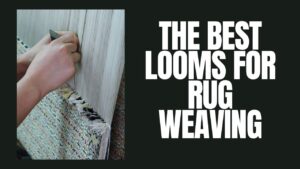This post has been in the works for a while now. It’s an answer to one of the most common questions I receive as a rug weaver and teacher- “What is the best loom for rug weaving?”
But alongside upright looms, you can use several different types of looms to weave rugs. I use both upright looms (also known as high warp looms) and floor looms (or low warp looms) for weaving rugs in my own studio.
And beyond the looms I use, and sell, there are a huge range of other looms available on the market. To cover them properly, I’ve split this topic up into two blog posts.
In today’s post, I’m going to walk you through the general qualities you should look for in a loom for rug weaving. And in the second part of this post- coming next week!- I’ll talk about the different types of looms more specifically, and the pros and cons of each one.
So without further ado, here are the factors to think about when you come to choose a loom for rug weaving.
Size
The first thing to think about is the width of the rug you want to weave. You will need a loom with a weaving width wide enough to accomodate this. The weaving width is not the same as the width of the loom in total! A loom may be 2 metres wide, but the mechanisms within it will narrow the space you’re actually able to weave in.
For example, on the rug loom I designed and sell on my shop, I recommend a maximum weaving width of 70cm. The loom itself is 80cm wide, but you need to have enough of a margin on either side of the warp to pass around the selvedge with ease. So when you’re shopping for a loom, look at the weaving width.
Secondly, you need to think about how long you want your rug to be. On a frame loom, you are limited by the height of the frame- although you can build a frame to whatever size you want! And on my rug looms, you can actually warp them continuously and create a rug that is almost twice the length of the loom’s height.
Finally on a hand loom (i.e. a low warp or high warp floor loom) the warp is wound onto a warp beam and then tied onto to the cloth beam. So you can wind a really long length of warp onto the warp beam and weave a long rug that way.
Warp Weight
To weave a durable rug, you need a thick and sturdy warp. Unfortunately, not all looms are able to accomodate this.
On a notched frame loom, for example, you may find that the notches are not wide enough to fit a thicker warp. This is why my rug looms actually don’t have notches at all.
Instead, I mark the warp spacing out onto the cross bars, and wind the warp around to those marks. This allows maximum flexibility. You can have a thick warp, thin warp, double warp or continuous warp- this loom has a lot of options.
On a hand loom, the thickness of your warp is limited by the reed. The reed is the metal grill at the front of the loom. The warp is threaded through each dent, or every other dent, and this keeps them evenly spaced and allows you to beat down the weft as you weave.
Some reeds are actually too fine to accomodate a rug warp, so check before you buy! The good news is that you can always swap out the reed that comes with your loom. In my studio I have a number of different reeds, ranging from 5dpi up to 10dpi.
I recommend having a selection to hand, and ideally knowing what thickness of warp you want to use for your rug before you choose a reed for your project.
Tension
The next thing you need to think about tension. When you are weaving a rug, the warp should be straight and rod-like in the centre of the fabric. The weft should be winding over and under each warp in a waving line.
So you need a loom that is strong enough to withstand the pressure of the warp being wound tightly onto it, and sturdy enough to maintain this tension.
If you’re working on a frame loom, you need to be able to wind the warp onto it without it bending, buckling or breaking. My preferred method for warping a frame loom is to wind the warp in a continuous loop around the outside frame and then bring the front and back warps into a flat layer in the centre.
This means you’re creating tension twice- once when you wind the warp around the loom and again when you bring the layers into the centre, pulling them tighter.
If you’re using a low or high warp loom, the warp will be wound onto a warp beam and then tied onto to the cloth beam. Most looms like this have ratchet and pawl mechanisms which allow you to increase the tension when you wind the cloth beam forwards or the warp beam backwards. However not all looms have particularly strong tension mechanisms! And some of them are simply not designed for the pressure of a tight rug warp. I’ll discuss this in more depth next week.
Additional Mechanisms
As well as the mechanisms for adding tension, you will want to think about what other mechanisms your loom will have to make rug weaving faster or easier. These mechanisms include shed sticks, heddle rods, shafts and beaters.
My rug looms have a shed stick and heddle rod, which helps raise and lower the alternating warps to make weaving easier. You can pass the weft across the loom in one smooth motion, rather than threading over and under each warp by hand.
A similar mechanism exists on hand looms. Here the warp is threaded through string or metal heddles which sit in frames called shafts. The shafts are connected to the treadles under the loom. When you press down on the treadles the shafts are raised and lowered, raising and lowering the warp with it, and opening a space for the weft to pass through.
Finally as I mentioned earlier, hand looms come with beaters. The beater is a swinging frame that contains the reed. This keeps each warp in place and can also be swung forward to beat the weft down firmly. But I find even on a loom with a reed, I still end up using a comb or hand-beater to make sure my weft is really firm.
Physical Strain
Finally, when you choose a loom you will need to think about the physical strain. Weaving on a large scale is time-consuming and slow. You will be sitting or standing in one position for a long time, so it’s necessary to choose a loom that works for your strength and fitness level.
Personally, I find standing upright at the loom is my preferred way to weave. I warp my rug looms with a continuous warp, allowing me to adjust the height as I weave and stay standing up.
You may find standing up for a long period is tiring for you. If you prefer to sit at the loom, a low warp loom may be preferable. These do tend to be less of a strain, and if you sit on a lower stool or bench, you are able to avoid hunching over as you weave, and put less strain on your back.
I hope this post has been a good introduction to the different aspects to consider when choosing a loom for weaving rugs. In next week’s post, I’ll talk you through some of the most common looms available and their suitability for rug weaving.



